Diploma of Nursing: Comprehensive Case Study on Emphysema and Stroke
VerifiedAdded on 2023/06/15
|11
|2343
|339
Case Study
AI Summary
This assignment presents a detailed case study focusing on various health conditions, including emphysema, angina, myocardial infarction, stroke, and benign prostatic hyperplasia. It explores the pathophysiology, symptoms, and management strategies for each condition. The case study also emphasizes the role of allied health professionals in patient care and rehabilitation, covering aspects such as physiotherapy, occupational therapy, and nutritional support. Furthermore, it includes an analysis of transient ischemic attacks (TIAs) and their implications, along with the FAST acronym for stroke detection. The assignment concludes with a section on pulmonary embolism, differentiating between pleurisy, pneumonia, atherosclerosis, and pneumothorax.
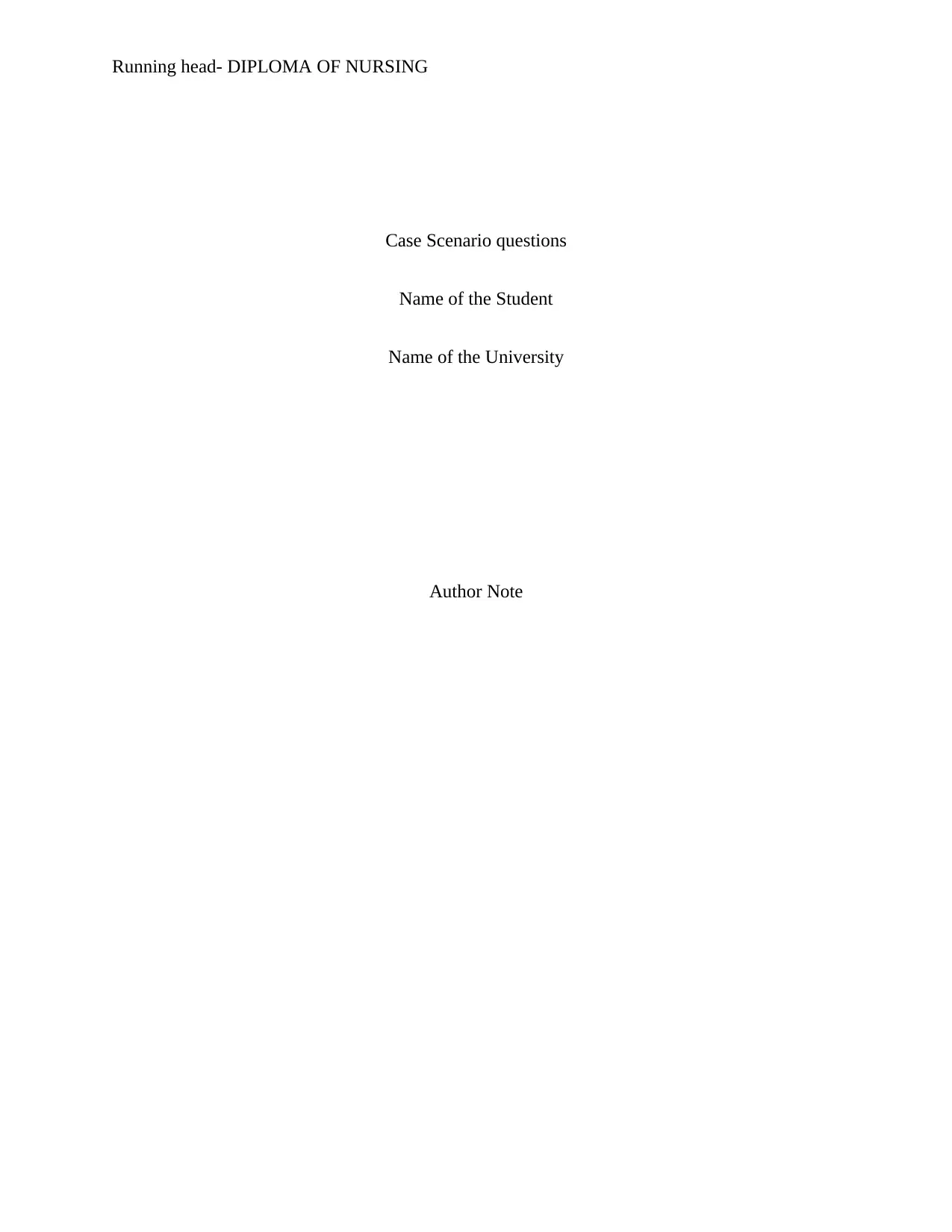
Running head- DIPLOMA OF NURSING
Case Scenario questions
Name of the Student
Name of the University
Author Note
Case Scenario questions
Name of the Student
Name of the University
Author Note
Paraphrase This Document
Need a fresh take? Get an instant paraphrase of this document with our AI Paraphraser
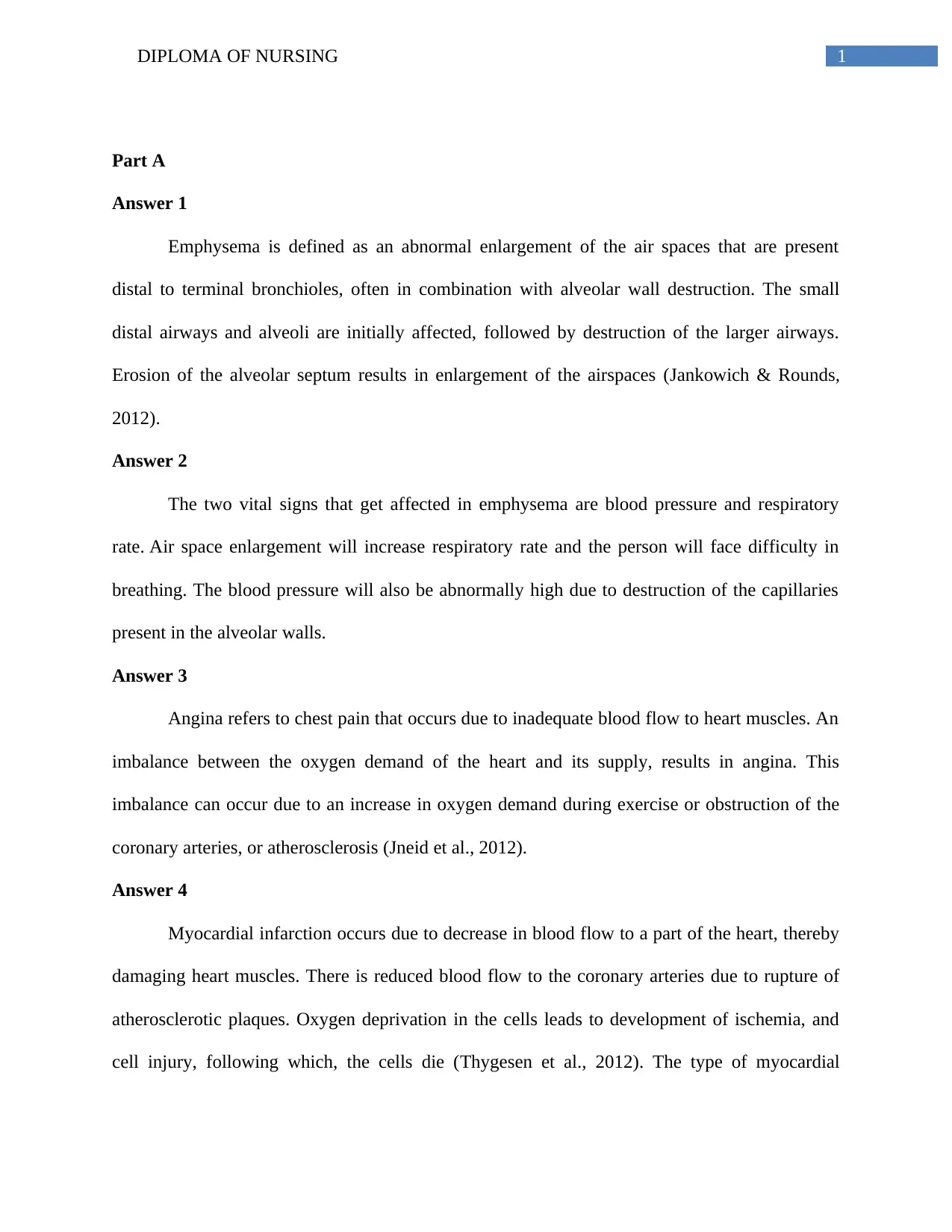
1DIPLOMA OF NURSING
Part A
Answer 1
Emphysema is defined as an abnormal enlargement of the air spaces that are present
distal to terminal bronchioles, often in combination with alveolar wall destruction. The small
distal airways and alveoli are initially affected, followed by destruction of the larger airways.
Erosion of the alveolar septum results in enlargement of the airspaces (Jankowich & Rounds,
2012).
Answer 2
The two vital signs that get affected in emphysema are blood pressure and respiratory
rate. Air space enlargement will increase respiratory rate and the person will face difficulty in
breathing. The blood pressure will also be abnormally high due to destruction of the capillaries
present in the alveolar walls.
Answer 3
Angina refers to chest pain that occurs due to inadequate blood flow to heart muscles. An
imbalance between the oxygen demand of the heart and its supply, results in angina. This
imbalance can occur due to an increase in oxygen demand during exercise or obstruction of the
coronary arteries, or atherosclerosis (Jneid et al., 2012).
Answer 4
Myocardial infarction occurs due to decrease in blood flow to a part of the heart, thereby
damaging heart muscles. There is reduced blood flow to the coronary arteries due to rupture of
atherosclerotic plaques. Oxygen deprivation in the cells leads to development of ischemia, and
cell injury, following which, the cells die (Thygesen et al., 2012). The type of myocardial
Part A
Answer 1
Emphysema is defined as an abnormal enlargement of the air spaces that are present
distal to terminal bronchioles, often in combination with alveolar wall destruction. The small
distal airways and alveoli are initially affected, followed by destruction of the larger airways.
Erosion of the alveolar septum results in enlargement of the airspaces (Jankowich & Rounds,
2012).
Answer 2
The two vital signs that get affected in emphysema are blood pressure and respiratory
rate. Air space enlargement will increase respiratory rate and the person will face difficulty in
breathing. The blood pressure will also be abnormally high due to destruction of the capillaries
present in the alveolar walls.
Answer 3
Angina refers to chest pain that occurs due to inadequate blood flow to heart muscles. An
imbalance between the oxygen demand of the heart and its supply, results in angina. This
imbalance can occur due to an increase in oxygen demand during exercise or obstruction of the
coronary arteries, or atherosclerosis (Jneid et al., 2012).
Answer 4
Myocardial infarction occurs due to decrease in blood flow to a part of the heart, thereby
damaging heart muscles. There is reduced blood flow to the coronary arteries due to rupture of
atherosclerotic plaques. Oxygen deprivation in the cells leads to development of ischemia, and
cell injury, following which, the cells die (Thygesen et al., 2012). The type of myocardial
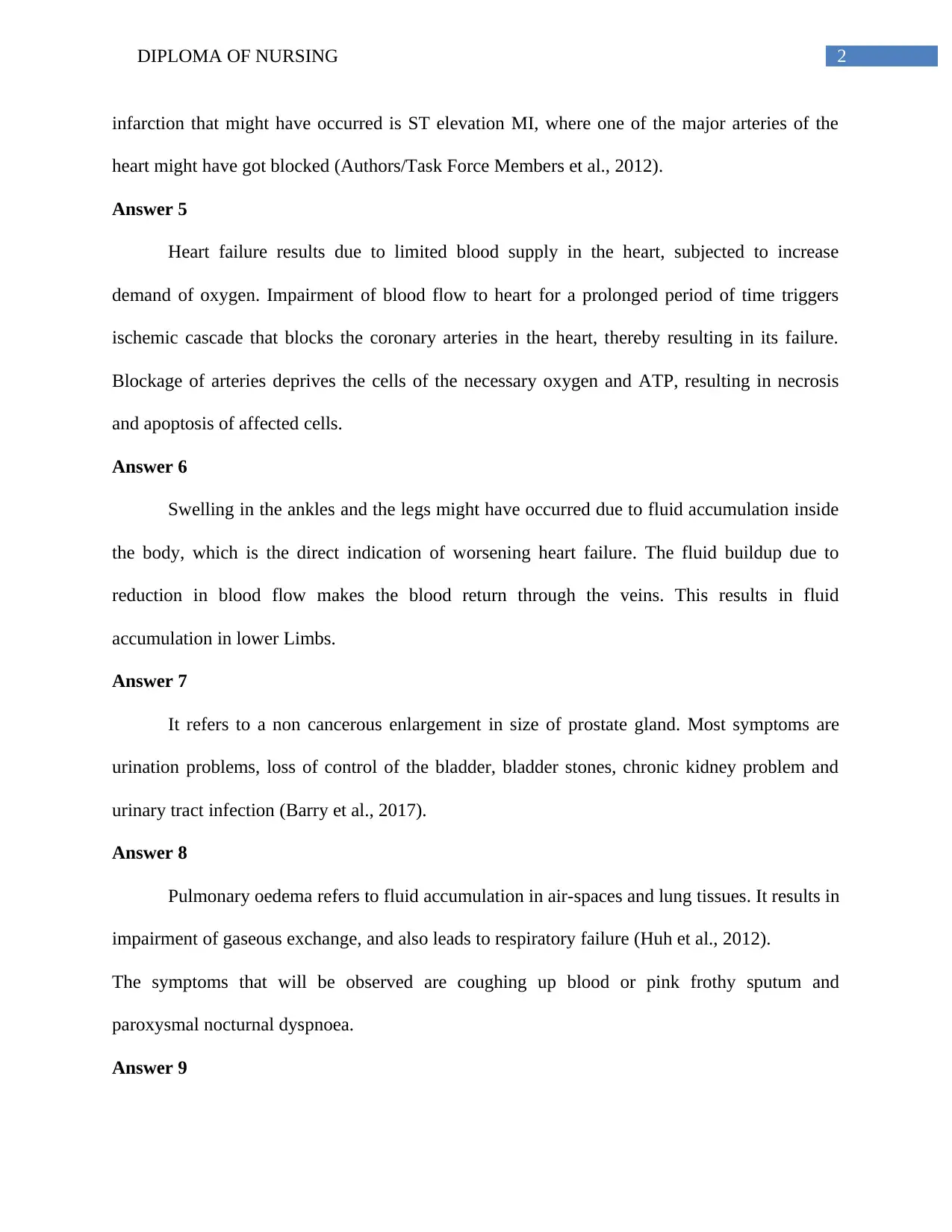
2DIPLOMA OF NURSING
infarction that might have occurred is ST elevation MI, where one of the major arteries of the
heart might have got blocked (Authors/Task Force Members et al., 2012).
Answer 5
Heart failure results due to limited blood supply in the heart, subjected to increase
demand of oxygen. Impairment of blood flow to heart for a prolonged period of time triggers
ischemic cascade that blocks the coronary arteries in the heart, thereby resulting in its failure.
Blockage of arteries deprives the cells of the necessary oxygen and ATP, resulting in necrosis
and apoptosis of affected cells.
Answer 6
Swelling in the ankles and the legs might have occurred due to fluid accumulation inside
the body, which is the direct indication of worsening heart failure. The fluid buildup due to
reduction in blood flow makes the blood return through the veins. This results in fluid
accumulation in lower Limbs.
Answer 7
It refers to a non cancerous enlargement in size of prostate gland. Most symptoms are
urination problems, loss of control of the bladder, bladder stones, chronic kidney problem and
urinary tract infection (Barry et al., 2017).
Answer 8
Pulmonary oedema refers to fluid accumulation in air-spaces and lung tissues. It results in
impairment of gaseous exchange, and also leads to respiratory failure (Huh et al., 2012).
The symptoms that will be observed are coughing up blood or pink frothy sputum and
paroxysmal nocturnal dyspnoea.
Answer 9
infarction that might have occurred is ST elevation MI, where one of the major arteries of the
heart might have got blocked (Authors/Task Force Members et al., 2012).
Answer 5
Heart failure results due to limited blood supply in the heart, subjected to increase
demand of oxygen. Impairment of blood flow to heart for a prolonged period of time triggers
ischemic cascade that blocks the coronary arteries in the heart, thereby resulting in its failure.
Blockage of arteries deprives the cells of the necessary oxygen and ATP, resulting in necrosis
and apoptosis of affected cells.
Answer 6
Swelling in the ankles and the legs might have occurred due to fluid accumulation inside
the body, which is the direct indication of worsening heart failure. The fluid buildup due to
reduction in blood flow makes the blood return through the veins. This results in fluid
accumulation in lower Limbs.
Answer 7
It refers to a non cancerous enlargement in size of prostate gland. Most symptoms are
urination problems, loss of control of the bladder, bladder stones, chronic kidney problem and
urinary tract infection (Barry et al., 2017).
Answer 8
Pulmonary oedema refers to fluid accumulation in air-spaces and lung tissues. It results in
impairment of gaseous exchange, and also leads to respiratory failure (Huh et al., 2012).
The symptoms that will be observed are coughing up blood or pink frothy sputum and
paroxysmal nocturnal dyspnoea.
Answer 9
⊘ This is a preview!⊘
Do you want full access?
Subscribe today to unlock all pages.

Trusted by 1+ million students worldwide
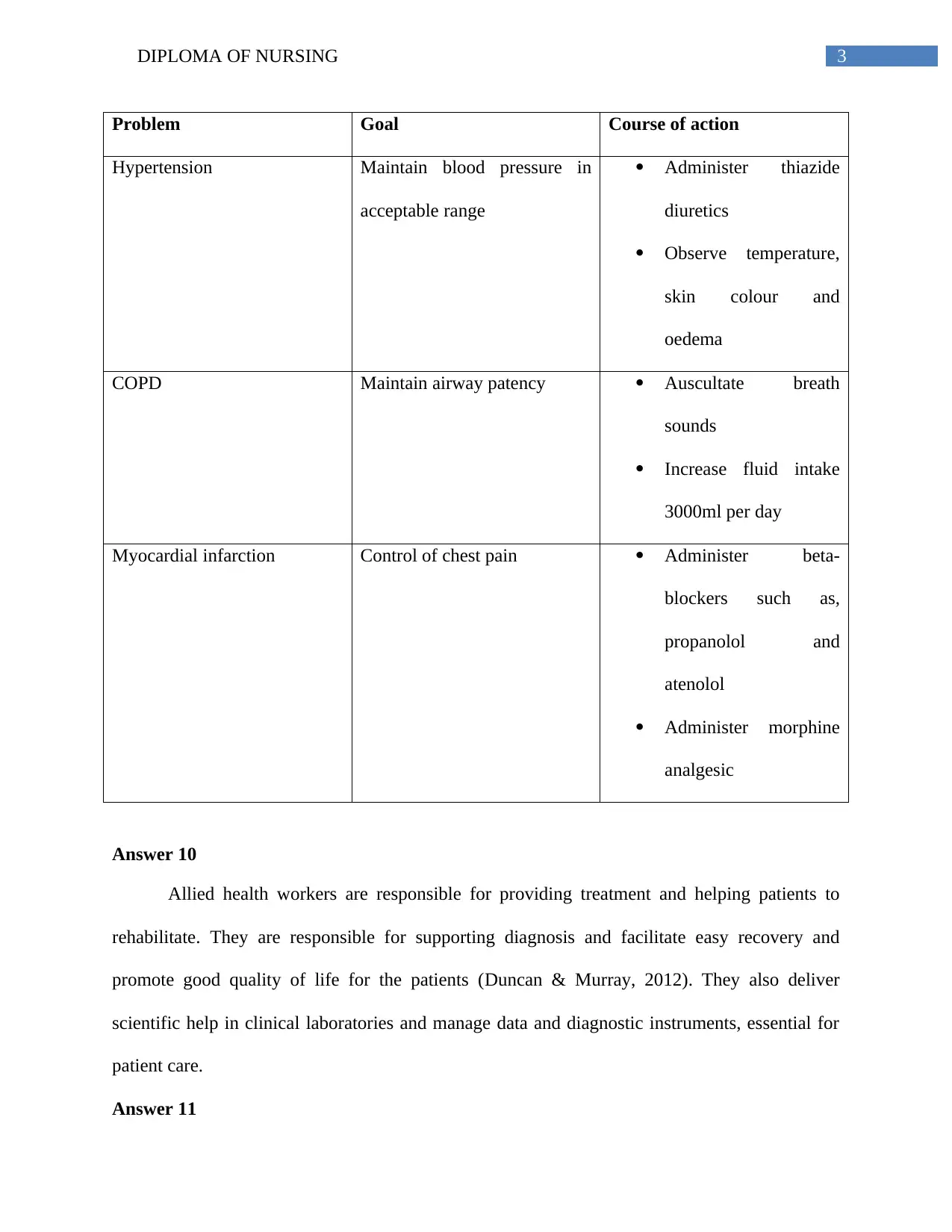
3DIPLOMA OF NURSING
Problem Goal Course of action
Hypertension Maintain blood pressure in
acceptable range
Administer thiazide
diuretics
Observe temperature,
skin colour and
oedema
COPD Maintain airway patency Auscultate breath
sounds
Increase fluid intake
3000ml per day
Myocardial infarction Control of chest pain Administer beta-
blockers such as,
propanolol and
atenolol
Administer morphine
analgesic
Answer 10
Allied health workers are responsible for providing treatment and helping patients to
rehabilitate. They are responsible for supporting diagnosis and facilitate easy recovery and
promote good quality of life for the patients (Duncan & Murray, 2012). They also deliver
scientific help in clinical laboratories and manage data and diagnostic instruments, essential for
patient care.
Answer 11
Problem Goal Course of action
Hypertension Maintain blood pressure in
acceptable range
Administer thiazide
diuretics
Observe temperature,
skin colour and
oedema
COPD Maintain airway patency Auscultate breath
sounds
Increase fluid intake
3000ml per day
Myocardial infarction Control of chest pain Administer beta-
blockers such as,
propanolol and
atenolol
Administer morphine
analgesic
Answer 10
Allied health workers are responsible for providing treatment and helping patients to
rehabilitate. They are responsible for supporting diagnosis and facilitate easy recovery and
promote good quality of life for the patients (Duncan & Murray, 2012). They also deliver
scientific help in clinical laboratories and manage data and diagnostic instruments, essential for
patient care.
Answer 11
Paraphrase This Document
Need a fresh take? Get an instant paraphrase of this document with our AI Paraphraser
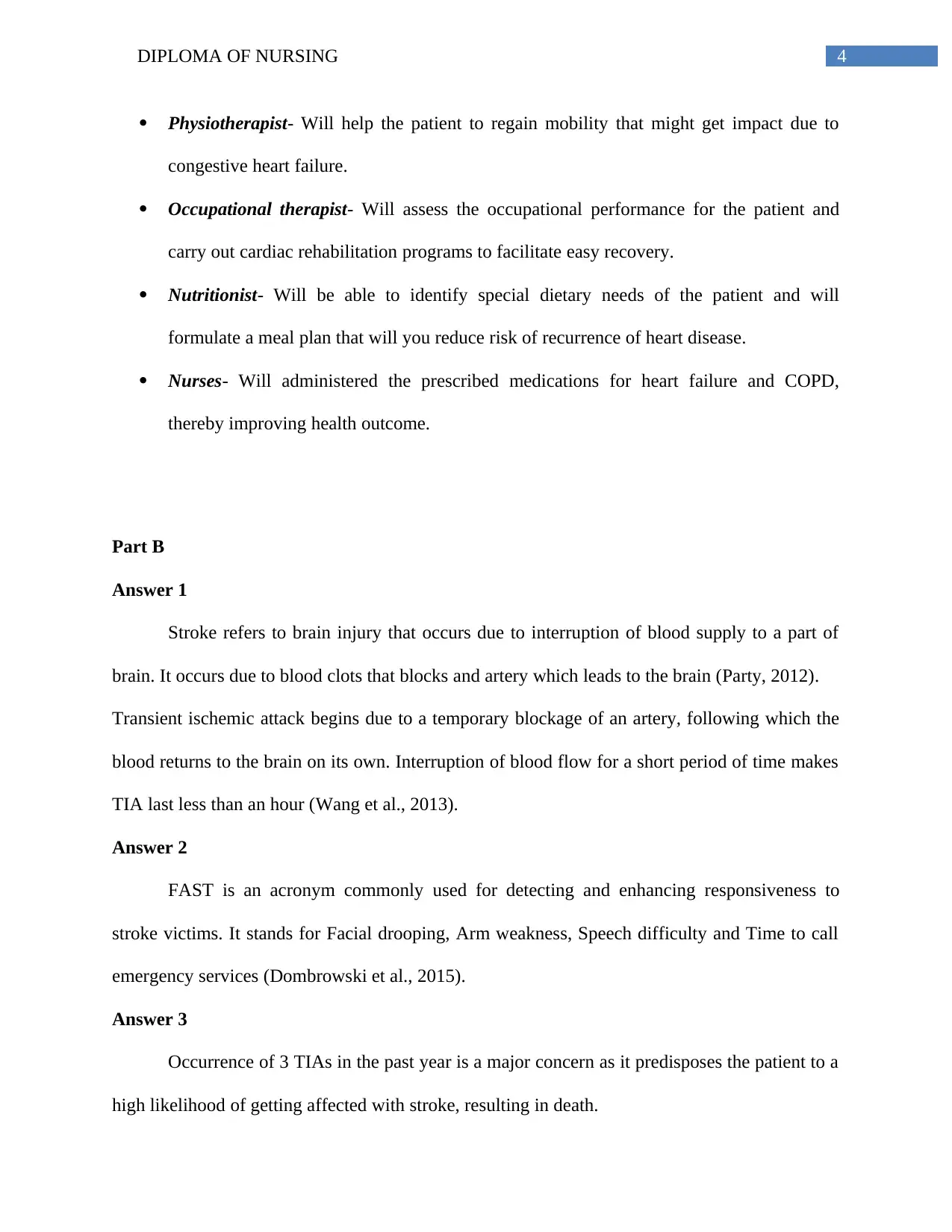
4DIPLOMA OF NURSING
Physiotherapist- Will help the patient to regain mobility that might get impact due to
congestive heart failure.
Occupational therapist- Will assess the occupational performance for the patient and
carry out cardiac rehabilitation programs to facilitate easy recovery.
Nutritionist- Will be able to identify special dietary needs of the patient and will
formulate a meal plan that will you reduce risk of recurrence of heart disease.
Nurses- Will administered the prescribed medications for heart failure and COPD,
thereby improving health outcome.
Part B
Answer 1
Stroke refers to brain injury that occurs due to interruption of blood supply to a part of
brain. It occurs due to blood clots that blocks and artery which leads to the brain (Party, 2012).
Transient ischemic attack begins due to a temporary blockage of an artery, following which the
blood returns to the brain on its own. Interruption of blood flow for a short period of time makes
TIA last less than an hour (Wang et al., 2013).
Answer 2
FAST is an acronym commonly used for detecting and enhancing responsiveness to
stroke victims. It stands for Facial drooping, Arm weakness, Speech difficulty and Time to call
emergency services (Dombrowski et al., 2015).
Answer 3
Occurrence of 3 TIAs in the past year is a major concern as it predisposes the patient to a
high likelihood of getting affected with stroke, resulting in death.
Physiotherapist- Will help the patient to regain mobility that might get impact due to
congestive heart failure.
Occupational therapist- Will assess the occupational performance for the patient and
carry out cardiac rehabilitation programs to facilitate easy recovery.
Nutritionist- Will be able to identify special dietary needs of the patient and will
formulate a meal plan that will you reduce risk of recurrence of heart disease.
Nurses- Will administered the prescribed medications for heart failure and COPD,
thereby improving health outcome.
Part B
Answer 1
Stroke refers to brain injury that occurs due to interruption of blood supply to a part of
brain. It occurs due to blood clots that blocks and artery which leads to the brain (Party, 2012).
Transient ischemic attack begins due to a temporary blockage of an artery, following which the
blood returns to the brain on its own. Interruption of blood flow for a short period of time makes
TIA last less than an hour (Wang et al., 2013).
Answer 2
FAST is an acronym commonly used for detecting and enhancing responsiveness to
stroke victims. It stands for Facial drooping, Arm weakness, Speech difficulty and Time to call
emergency services (Dombrowski et al., 2015).
Answer 3
Occurrence of 3 TIAs in the past year is a major concern as it predisposes the patient to a
high likelihood of getting affected with stroke, resulting in death.
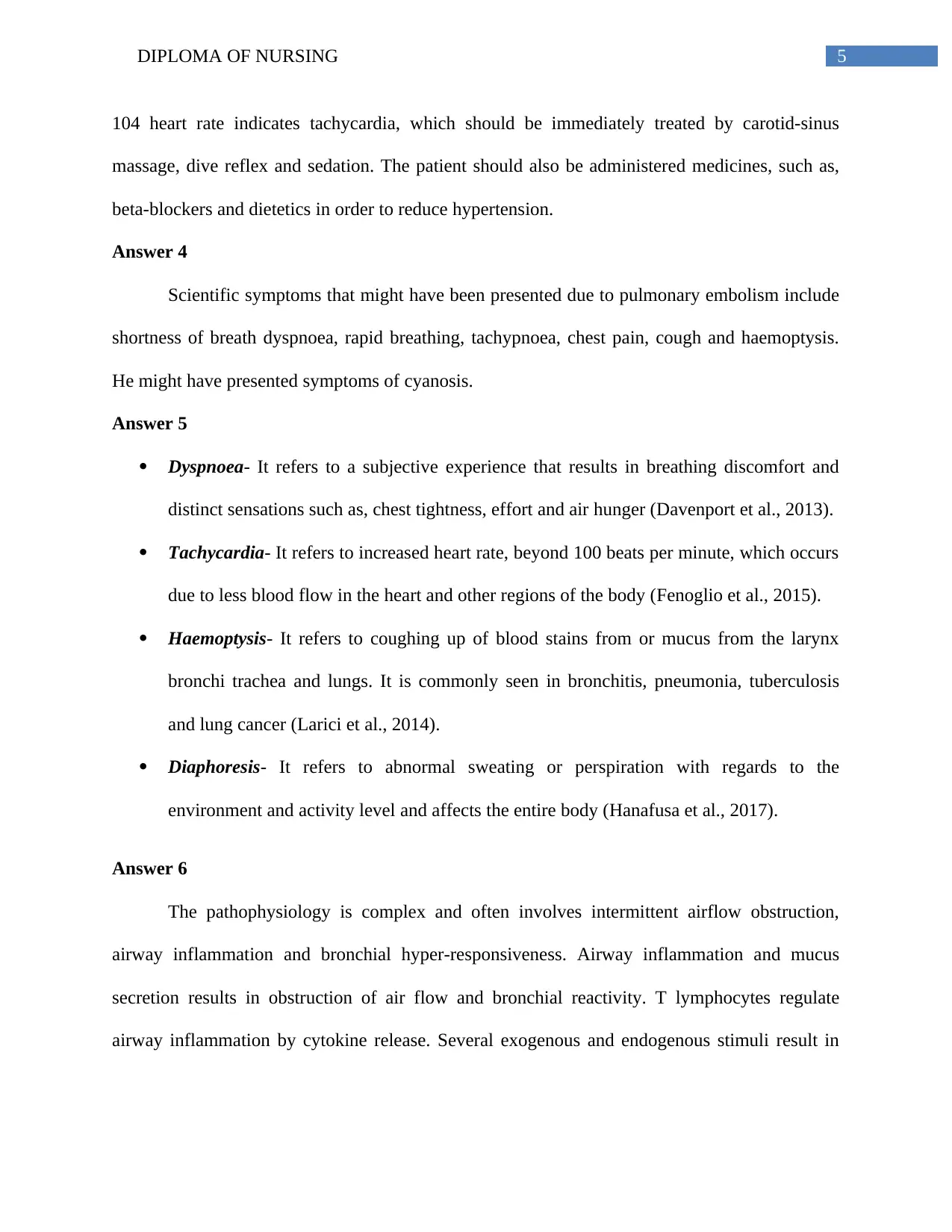
5DIPLOMA OF NURSING
104 heart rate indicates tachycardia, which should be immediately treated by carotid-sinus
massage, dive reflex and sedation. The patient should also be administered medicines, such as,
beta-blockers and dietetics in order to reduce hypertension.
Answer 4
Scientific symptoms that might have been presented due to pulmonary embolism include
shortness of breath dyspnoea, rapid breathing, tachypnoea, chest pain, cough and haemoptysis.
He might have presented symptoms of cyanosis.
Answer 5
Dyspnoea- It refers to a subjective experience that results in breathing discomfort and
distinct sensations such as, chest tightness, effort and air hunger (Davenport et al., 2013).
Tachycardia- It refers to increased heart rate, beyond 100 beats per minute, which occurs
due to less blood flow in the heart and other regions of the body (Fenoglio et al., 2015).
Haemoptysis- It refers to coughing up of blood stains from or mucus from the larynx
bronchi trachea and lungs. It is commonly seen in bronchitis, pneumonia, tuberculosis
and lung cancer (Larici et al., 2014).
Diaphoresis- It refers to abnormal sweating or perspiration with regards to the
environment and activity level and affects the entire body (Hanafusa et al., 2017).
Answer 6
The pathophysiology is complex and often involves intermittent airflow obstruction,
airway inflammation and bronchial hyper-responsiveness. Airway inflammation and mucus
secretion results in obstruction of air flow and bronchial reactivity. T lymphocytes regulate
airway inflammation by cytokine release. Several exogenous and endogenous stimuli result in
104 heart rate indicates tachycardia, which should be immediately treated by carotid-sinus
massage, dive reflex and sedation. The patient should also be administered medicines, such as,
beta-blockers and dietetics in order to reduce hypertension.
Answer 4
Scientific symptoms that might have been presented due to pulmonary embolism include
shortness of breath dyspnoea, rapid breathing, tachypnoea, chest pain, cough and haemoptysis.
He might have presented symptoms of cyanosis.
Answer 5
Dyspnoea- It refers to a subjective experience that results in breathing discomfort and
distinct sensations such as, chest tightness, effort and air hunger (Davenport et al., 2013).
Tachycardia- It refers to increased heart rate, beyond 100 beats per minute, which occurs
due to less blood flow in the heart and other regions of the body (Fenoglio et al., 2015).
Haemoptysis- It refers to coughing up of blood stains from or mucus from the larynx
bronchi trachea and lungs. It is commonly seen in bronchitis, pneumonia, tuberculosis
and lung cancer (Larici et al., 2014).
Diaphoresis- It refers to abnormal sweating or perspiration with regards to the
environment and activity level and affects the entire body (Hanafusa et al., 2017).
Answer 6
The pathophysiology is complex and often involves intermittent airflow obstruction,
airway inflammation and bronchial hyper-responsiveness. Airway inflammation and mucus
secretion results in obstruction of air flow and bronchial reactivity. T lymphocytes regulate
airway inflammation by cytokine release. Several exogenous and endogenous stimuli result in
⊘ This is a preview!⊘
Do you want full access?
Subscribe today to unlock all pages.

Trusted by 1+ million students worldwide
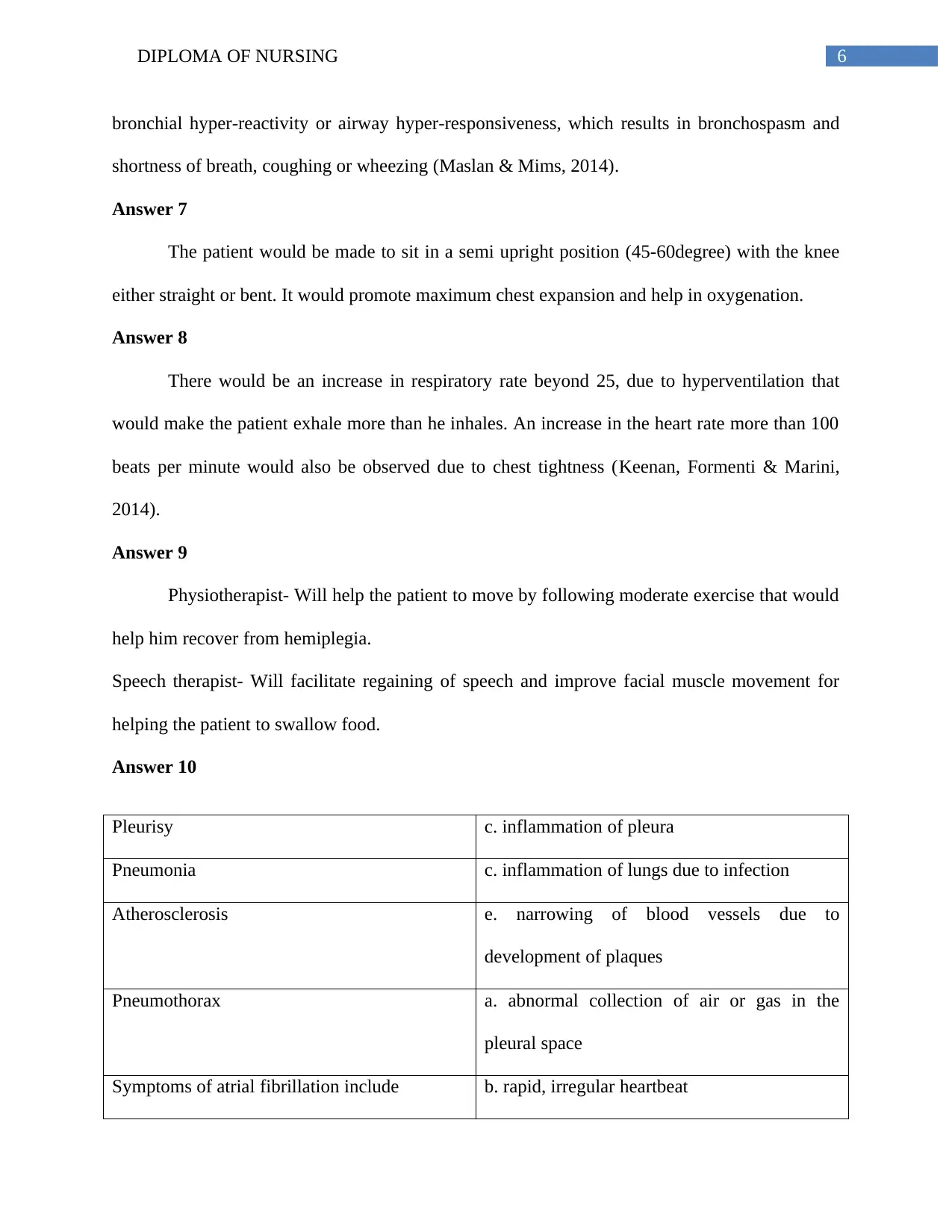
6DIPLOMA OF NURSING
bronchial hyper-reactivity or airway hyper-responsiveness, which results in bronchospasm and
shortness of breath, coughing or wheezing (Maslan & Mims, 2014).
Answer 7
The patient would be made to sit in a semi upright position (45-60degree) with the knee
either straight or bent. It would promote maximum chest expansion and help in oxygenation.
Answer 8
There would be an increase in respiratory rate beyond 25, due to hyperventilation that
would make the patient exhale more than he inhales. An increase in the heart rate more than 100
beats per minute would also be observed due to chest tightness (Keenan, Formenti & Marini,
2014).
Answer 9
Physiotherapist- Will help the patient to move by following moderate exercise that would
help him recover from hemiplegia.
Speech therapist- Will facilitate regaining of speech and improve facial muscle movement for
helping the patient to swallow food.
Answer 10
Pleurisy c. inflammation of pleura
Pneumonia c. inflammation of lungs due to infection
Atherosclerosis e. narrowing of blood vessels due to
development of plaques
Pneumothorax a. abnormal collection of air or gas in the
pleural space
Symptoms of atrial fibrillation include b. rapid, irregular heartbeat
bronchial hyper-reactivity or airway hyper-responsiveness, which results in bronchospasm and
shortness of breath, coughing or wheezing (Maslan & Mims, 2014).
Answer 7
The patient would be made to sit in a semi upright position (45-60degree) with the knee
either straight or bent. It would promote maximum chest expansion and help in oxygenation.
Answer 8
There would be an increase in respiratory rate beyond 25, due to hyperventilation that
would make the patient exhale more than he inhales. An increase in the heart rate more than 100
beats per minute would also be observed due to chest tightness (Keenan, Formenti & Marini,
2014).
Answer 9
Physiotherapist- Will help the patient to move by following moderate exercise that would
help him recover from hemiplegia.
Speech therapist- Will facilitate regaining of speech and improve facial muscle movement for
helping the patient to swallow food.
Answer 10
Pleurisy c. inflammation of pleura
Pneumonia c. inflammation of lungs due to infection
Atherosclerosis e. narrowing of blood vessels due to
development of plaques
Pneumothorax a. abnormal collection of air or gas in the
pleural space
Symptoms of atrial fibrillation include b. rapid, irregular heartbeat
Paraphrase This Document
Need a fresh take? Get an instant paraphrase of this document with our AI Paraphraser

7DIPLOMA OF NURSING
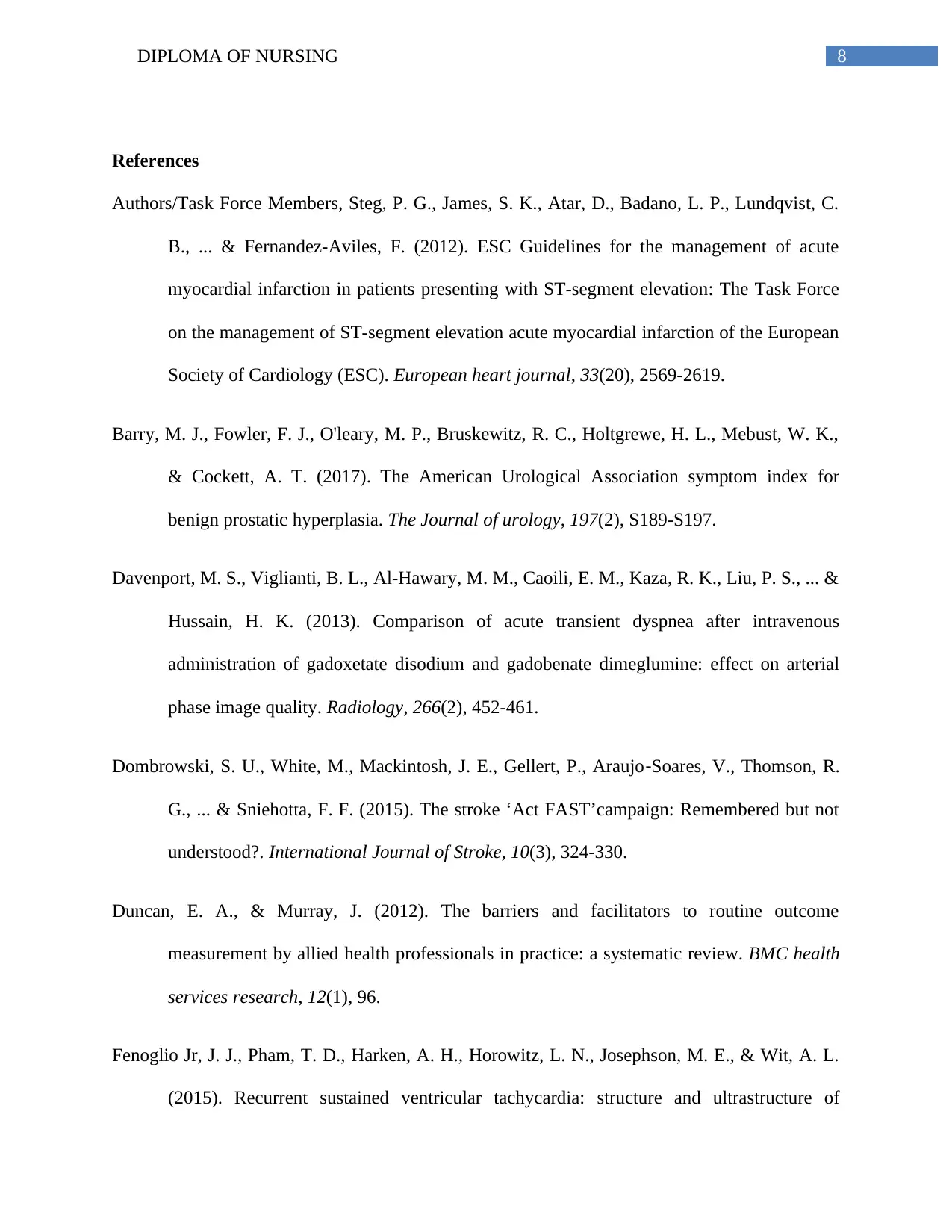
8DIPLOMA OF NURSING
References
Authors/Task Force Members, Steg, P. G., James, S. K., Atar, D., Badano, L. P., Lundqvist, C.
B., ... & Fernandez-Aviles, F. (2012). ESC Guidelines for the management of acute
myocardial infarction in patients presenting with ST-segment elevation: The Task Force
on the management of ST-segment elevation acute myocardial infarction of the European
Society of Cardiology (ESC). European heart journal, 33(20), 2569-2619.
Barry, M. J., Fowler, F. J., O'leary, M. P., Bruskewitz, R. C., Holtgrewe, H. L., Mebust, W. K.,
& Cockett, A. T. (2017). The American Urological Association symptom index for
benign prostatic hyperplasia. The Journal of urology, 197(2), S189-S197.
Davenport, M. S., Viglianti, B. L., Al-Hawary, M. M., Caoili, E. M., Kaza, R. K., Liu, P. S., ... &
Hussain, H. K. (2013). Comparison of acute transient dyspnea after intravenous
administration of gadoxetate disodium and gadobenate dimeglumine: effect on arterial
phase image quality. Radiology, 266(2), 452-461.
Dombrowski, S. U., White, M., Mackintosh, J. E., Gellert, P., Araujo‐Soares, V., Thomson, R.
G., ... & Sniehotta, F. F. (2015). The stroke ‘Act FAST’campaign: Remembered but not
understood?. International Journal of Stroke, 10(3), 324-330.
Duncan, E. A., & Murray, J. (2012). The barriers and facilitators to routine outcome
measurement by allied health professionals in practice: a systematic review. BMC health
services research, 12(1), 96.
Fenoglio Jr, J. J., Pham, T. D., Harken, A. H., Horowitz, L. N., Josephson, M. E., & Wit, A. L.
(2015). Recurrent sustained ventricular tachycardia: structure and ultrastructure of
References
Authors/Task Force Members, Steg, P. G., James, S. K., Atar, D., Badano, L. P., Lundqvist, C.
B., ... & Fernandez-Aviles, F. (2012). ESC Guidelines for the management of acute
myocardial infarction in patients presenting with ST-segment elevation: The Task Force
on the management of ST-segment elevation acute myocardial infarction of the European
Society of Cardiology (ESC). European heart journal, 33(20), 2569-2619.
Barry, M. J., Fowler, F. J., O'leary, M. P., Bruskewitz, R. C., Holtgrewe, H. L., Mebust, W. K.,
& Cockett, A. T. (2017). The American Urological Association symptom index for
benign prostatic hyperplasia. The Journal of urology, 197(2), S189-S197.
Davenport, M. S., Viglianti, B. L., Al-Hawary, M. M., Caoili, E. M., Kaza, R. K., Liu, P. S., ... &
Hussain, H. K. (2013). Comparison of acute transient dyspnea after intravenous
administration of gadoxetate disodium and gadobenate dimeglumine: effect on arterial
phase image quality. Radiology, 266(2), 452-461.
Dombrowski, S. U., White, M., Mackintosh, J. E., Gellert, P., Araujo‐Soares, V., Thomson, R.
G., ... & Sniehotta, F. F. (2015). The stroke ‘Act FAST’campaign: Remembered but not
understood?. International Journal of Stroke, 10(3), 324-330.
Duncan, E. A., & Murray, J. (2012). The barriers and facilitators to routine outcome
measurement by allied health professionals in practice: a systematic review. BMC health
services research, 12(1), 96.
Fenoglio Jr, J. J., Pham, T. D., Harken, A. H., Horowitz, L. N., Josephson, M. E., & Wit, A. L.
(2015). Recurrent sustained ventricular tachycardia: structure and ultrastructure of
⊘ This is a preview!⊘
Do you want full access?
Subscribe today to unlock all pages.

Trusted by 1+ million students worldwide
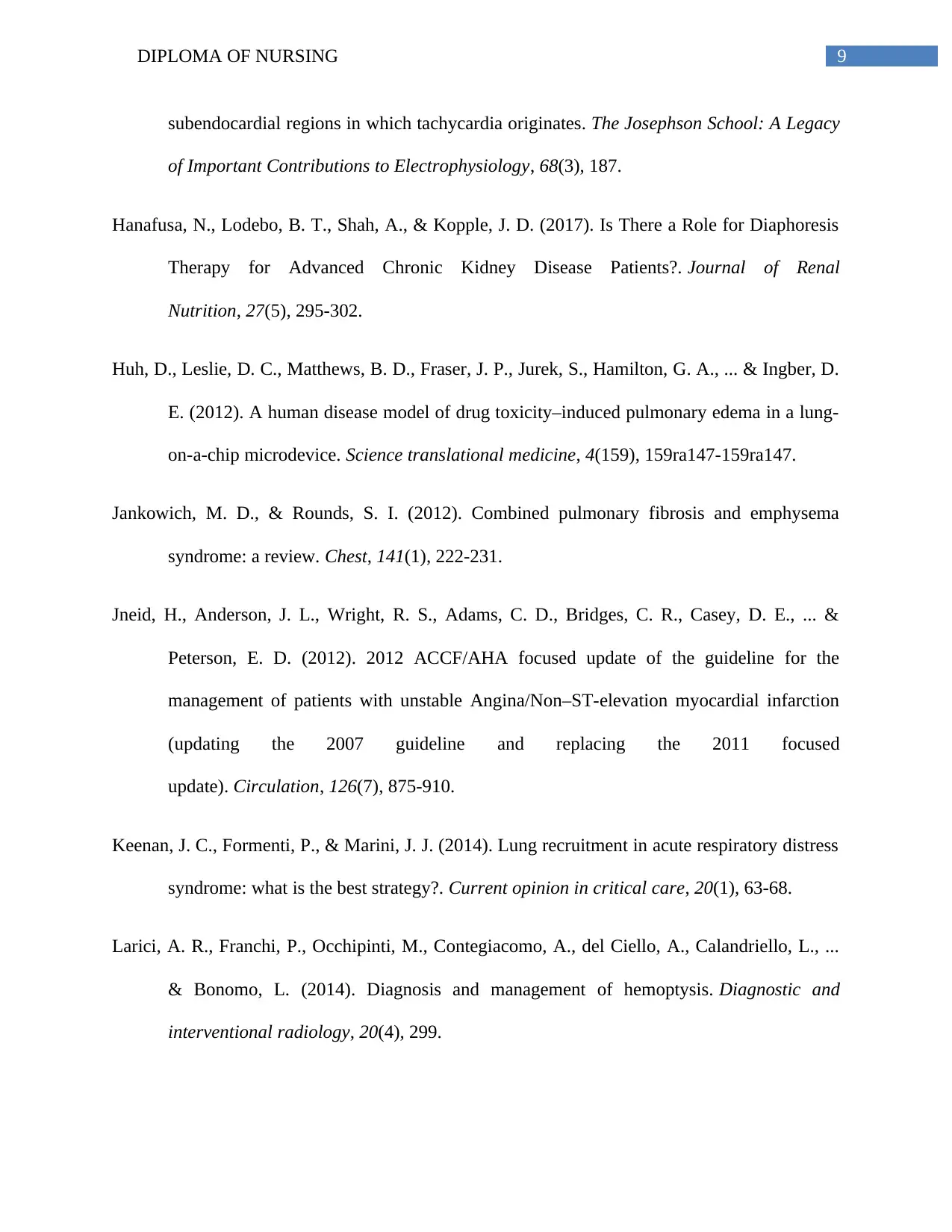
9DIPLOMA OF NURSING
subendocardial regions in which tachycardia originates. The Josephson School: A Legacy
of Important Contributions to Electrophysiology, 68(3), 187.
Hanafusa, N., Lodebo, B. T., Shah, A., & Kopple, J. D. (2017). Is There a Role for Diaphoresis
Therapy for Advanced Chronic Kidney Disease Patients?. Journal of Renal
Nutrition, 27(5), 295-302.
Huh, D., Leslie, D. C., Matthews, B. D., Fraser, J. P., Jurek, S., Hamilton, G. A., ... & Ingber, D.
E. (2012). A human disease model of drug toxicity–induced pulmonary edema in a lung-
on-a-chip microdevice. Science translational medicine, 4(159), 159ra147-159ra147.
Jankowich, M. D., & Rounds, S. I. (2012). Combined pulmonary fibrosis and emphysema
syndrome: a review. Chest, 141(1), 222-231.
Jneid, H., Anderson, J. L., Wright, R. S., Adams, C. D., Bridges, C. R., Casey, D. E., ... &
Peterson, E. D. (2012). 2012 ACCF/AHA focused update of the guideline for the
management of patients with unstable Angina/Non–ST-elevation myocardial infarction
(updating the 2007 guideline and replacing the 2011 focused
update). Circulation, 126(7), 875-910.
Keenan, J. C., Formenti, P., & Marini, J. J. (2014). Lung recruitment in acute respiratory distress
syndrome: what is the best strategy?. Current opinion in critical care, 20(1), 63-68.
Larici, A. R., Franchi, P., Occhipinti, M., Contegiacomo, A., del Ciello, A., Calandriello, L., ...
& Bonomo, L. (2014). Diagnosis and management of hemoptysis. Diagnostic and
interventional radiology, 20(4), 299.
subendocardial regions in which tachycardia originates. The Josephson School: A Legacy
of Important Contributions to Electrophysiology, 68(3), 187.
Hanafusa, N., Lodebo, B. T., Shah, A., & Kopple, J. D. (2017). Is There a Role for Diaphoresis
Therapy for Advanced Chronic Kidney Disease Patients?. Journal of Renal
Nutrition, 27(5), 295-302.
Huh, D., Leslie, D. C., Matthews, B. D., Fraser, J. P., Jurek, S., Hamilton, G. A., ... & Ingber, D.
E. (2012). A human disease model of drug toxicity–induced pulmonary edema in a lung-
on-a-chip microdevice. Science translational medicine, 4(159), 159ra147-159ra147.
Jankowich, M. D., & Rounds, S. I. (2012). Combined pulmonary fibrosis and emphysema
syndrome: a review. Chest, 141(1), 222-231.
Jneid, H., Anderson, J. L., Wright, R. S., Adams, C. D., Bridges, C. R., Casey, D. E., ... &
Peterson, E. D. (2012). 2012 ACCF/AHA focused update of the guideline for the
management of patients with unstable Angina/Non–ST-elevation myocardial infarction
(updating the 2007 guideline and replacing the 2011 focused
update). Circulation, 126(7), 875-910.
Keenan, J. C., Formenti, P., & Marini, J. J. (2014). Lung recruitment in acute respiratory distress
syndrome: what is the best strategy?. Current opinion in critical care, 20(1), 63-68.
Larici, A. R., Franchi, P., Occhipinti, M., Contegiacomo, A., del Ciello, A., Calandriello, L., ...
& Bonomo, L. (2014). Diagnosis and management of hemoptysis. Diagnostic and
interventional radiology, 20(4), 299.
Paraphrase This Document
Need a fresh take? Get an instant paraphrase of this document with our AI Paraphraser
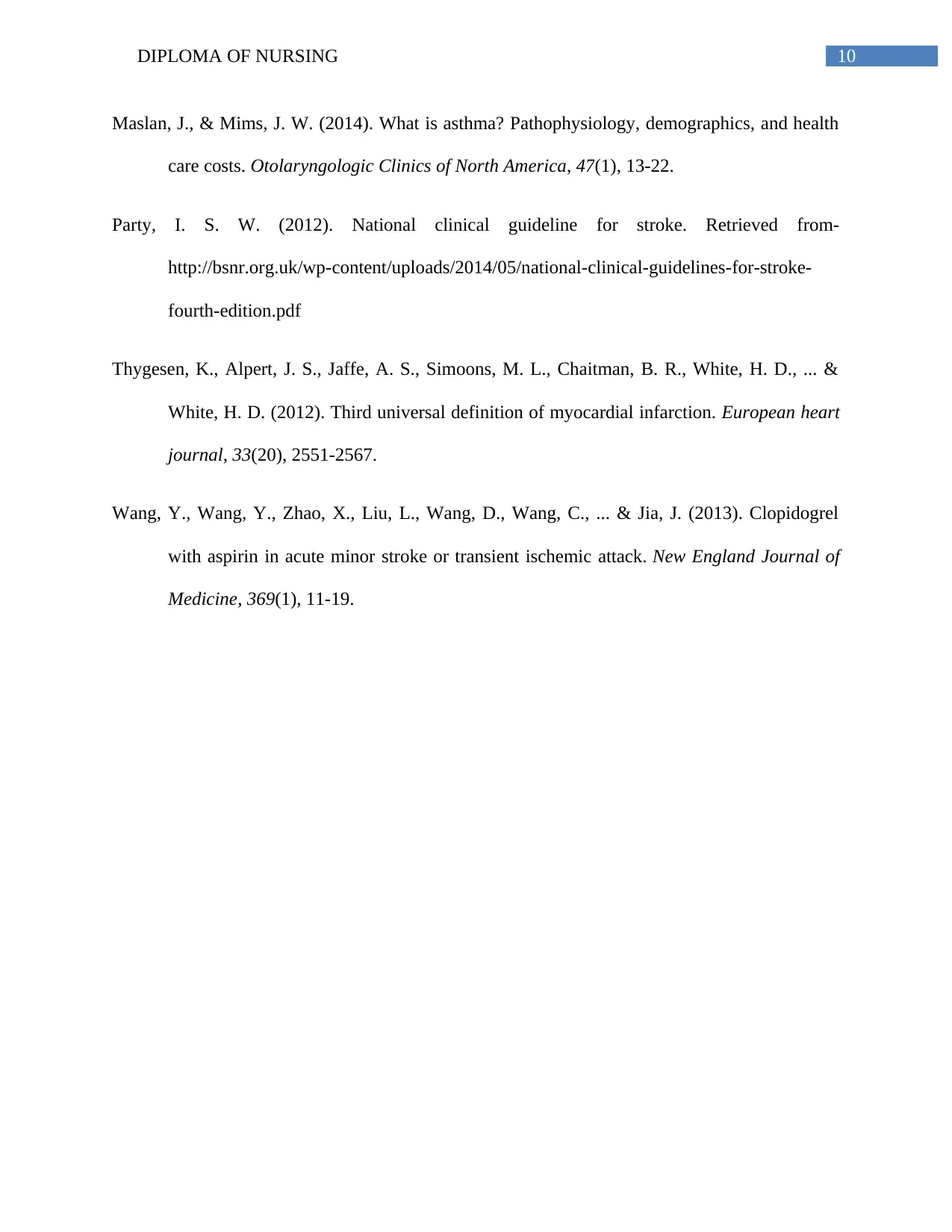
10DIPLOMA OF NURSING
Maslan, J., & Mims, J. W. (2014). What is asthma? Pathophysiology, demographics, and health
care costs. Otolaryngologic Clinics of North America, 47(1), 13-22.
Party, I. S. W. (2012). National clinical guideline for stroke. Retrieved from-
http://bsnr.org.uk/wp-content/uploads/2014/05/national-clinical-guidelines-for-stroke-
fourth-edition.pdf
Thygesen, K., Alpert, J. S., Jaffe, A. S., Simoons, M. L., Chaitman, B. R., White, H. D., ... &
White, H. D. (2012). Third universal definition of myocardial infarction. European heart
journal, 33(20), 2551-2567.
Wang, Y., Wang, Y., Zhao, X., Liu, L., Wang, D., Wang, C., ... & Jia, J. (2013). Clopidogrel
with aspirin in acute minor stroke or transient ischemic attack. New England Journal of
Medicine, 369(1), 11-19.
Maslan, J., & Mims, J. W. (2014). What is asthma? Pathophysiology, demographics, and health
care costs. Otolaryngologic Clinics of North America, 47(1), 13-22.
Party, I. S. W. (2012). National clinical guideline for stroke. Retrieved from-
http://bsnr.org.uk/wp-content/uploads/2014/05/national-clinical-guidelines-for-stroke-
fourth-edition.pdf
Thygesen, K., Alpert, J. S., Jaffe, A. S., Simoons, M. L., Chaitman, B. R., White, H. D., ... &
White, H. D. (2012). Third universal definition of myocardial infarction. European heart
journal, 33(20), 2551-2567.
Wang, Y., Wang, Y., Zhao, X., Liu, L., Wang, D., Wang, C., ... & Jia, J. (2013). Clopidogrel
with aspirin in acute minor stroke or transient ischemic attack. New England Journal of
Medicine, 369(1), 11-19.
1 out of 11
Related Documents
Your All-in-One AI-Powered Toolkit for Academic Success.
+13062052269
info@desklib.com
Available 24*7 on WhatsApp / Email
![[object Object]](/_next/static/media/star-bottom.7253800d.svg)
Unlock your academic potential
Copyright © 2020–2025 A2Z Services. All Rights Reserved. Developed and managed by ZUCOL.





